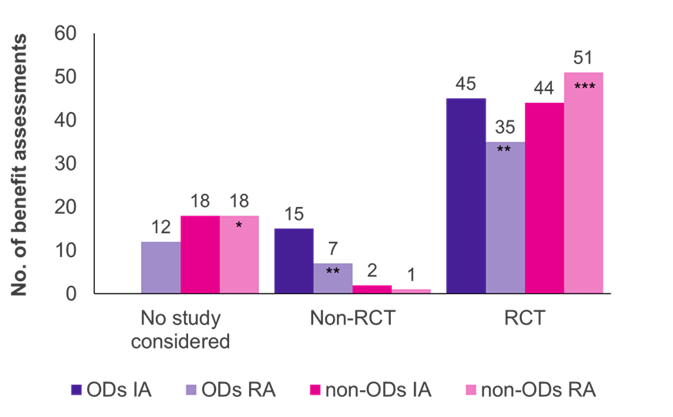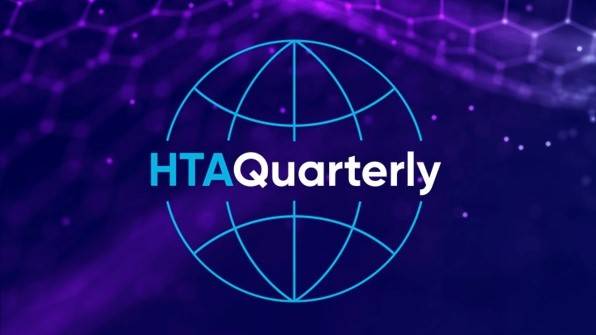Unveiling the evidence gap: Orphan drugs vs. non-orphan drugs in German health technology assessments

Rare diseases and their treatments in German HTA
For ODs, an added medical benefit is granted by law, and the extent assessment is based on pivotal evidence without the obligation to compare against an ACT. However, if sales reach €30 million or the indication loses orphan status, reassessment under the standard evaluation process becomes mandatory. Non-orphan drugs (non-ODs), being obligated to the regular benefit assessment, may also be subjected to a reassessment, either mandatorily in case of temporary decisions (e.g. additional data are requested by the G-BA) or at the request of the pharmaceutical manufacturer.
The benefit assessment is the basis for the price negotiation for reimbursement between the pharmaceutical manufacturer and the National Association of Statutory Health Insurance Funds (GKV-SV). Only drugs with an added medical benefit can achieve a higher price than the costs for the ACT in the price negotiation. Within the first six months after launch, the manufacturer is free to define the launch price, while the negotiated price is applied from the seventh month. The reimbursement price for a drug may further change with time when reassessments and new indications for the respective drug pass through HTA and subsequent price negotiations.
This article explores the results of an in-depth analysis of German HTAs centering on the comparison of evidence criteria and pricing between ODs and non-ODs (for both initial assessment and reassessment) and aims to shed light on whether ODs lack evidence in HTA compared to non-ODs.
A comprehensive review analysed benefit assessments for ODs and non-ODs from 2011 to May 2024 from a database of G-BA data. This analysis included 959 benefit assessments. Of these, 810 were initial assessments of newly authorised drugs or newly authorised indications of a drug, while 149 were reassessments, with some products being reassessed more than once for a respective indication. The analysis of 810 initial benefit assessments revealed that 27% of the assessments evaluated ODs, while 73% were non-ODs. In total, a reassessment was performed for 15% of all assessments (7% ODs and 8% non-ODs).
Any reassessments were matched to the respective initial benefit assessment, if applicable, to align related assessments for the same drug. Data were extracted for ODs and non-ODs focusing on parameters such as evidence assessed (study types, number of studies, and size of studies), level of added benefit granted, and price. Evaluations focused on cases with both initial assessment (60 ODs and 64 non-ODs) and reassessment (54 ODs and 70 non-ODs, reflecting that some drugs lost OD status from a prevalence perspective and were reassessed under the standard procedure as non-ODs) for a given indication to assess whether evidence, level of benefit, and price changed between initial assessment and reassessment, and to compare between ODs and non-ODs.

Comparability of presented evidence for ODs and non-ODs
Initially, the clinical studies submitted by the manufacturer were accepted by the G-BA in all OD assessments; the majority of studies (45/60 cases, 75%) were RCTs, and 25% (15/60 cases, 25%) were non-RCTs (e.g. single-arm trials, small study sizes, use of surrogate outcomes). When ODs were reassessed in a standard benefit assessment, having exceeded the sales limit, the proportion of accepted RCTs and non-RCTs decreased to 65% (35/54 reassessments) and 13% (7/54 reassessments), respectively. In 12 of the OD reassessments (22%), the respective studies were not accepted by the G-BA, reflecting the more stringent evidence criteria applied under the standard assessment process. Not meeting the ACT might be the main reason for this shift.
In contrast to ODs, very few non-RCTs were accepted in non-OD benefit assessments (2/64 initial assessments; 1/70 reassessments). Thus, non-RCTs appear more likely to be accepted for ODs than for non-ODs. Further, the manufacturer’s evidence was accepted in all OD initial assessments, whereas the presented studies were rejected in 18 assessments and reassessments of non-ODs. This is due to the fact that in OD assessments pivotal studies are always accepted by law.
Figure 1. Distribution of study type among ODs and non-ODs in the initial assessment (IA) and reassessment (RA)

Key: IA – initial assessment; No. – number; OD – orphan drug; RA – reassessment; RCT – randomised controlled trial.
Note: Six ODs, initially assessed as ODs, were reassessed as non-ODs due to loss of OD status (*added four former ODs; **reduced by three former ODs; ***added two former ODs).
Furthermore, and not surprisingly, there was a positive correlation between an increased size of study populations and the availability of an RCT (data not shown).
Distribution of granted added benefits for ODs and non-ODs in initial assessment
Figure 2. Granted added benefit in initial assessments

Key: No. – number; OD – orphan drug.
Benefit assessments result in a decrease of reimbursement prices (similar to ODs and non-ODs)

Orphan drugs: Balancing high costs with strong evidence
In conclusion, drugs developed for rare diseases present distinct challenges for manufacturers and HTA authorities. While ‘assessment privileges’ improve the availability of therapies for difficult-to-treat rare conditions, caution is warranted when evidence-based medicine criteria are applied. Our findings demonstrate that despite the obstacles faced by ODs, high-quality evidence in the form of RCTs is provided. However, the HTA system recognises the occasional infeasibility of RCTs in the field of rare diseases, while allowing more leeway in accepting non-RCTs in OD assessments.
While this article did not delve into the justification of ODs’ high prices, their efficacy correlation, or the rationale behind the granted added benefit, further evaluation is warranted to analyse these key aspects and their complexity within the German healthcare system. The interplay between the costs of ODs, the strength of evidence they offer, and the value they bring to healthcare systems remains a complex and evolving topic that necessitates continued scrutiny and analysis.
Sources
-
Bundesministerium für Gesundheit (BMG). Seltene Erkrankungen. 2024. Accessed 4 September 2024. https://www.bundesgesundheitsministerium.de/themen/praevention/gesundheitsgefahren/seltene-erkrankungen.html
-
Bundesministerium der Justiz (BMJ). Sozialgesetzbuch (SGB) Fünftes Buch (V). Accessed 4 September 2024. https://www.gesetze-im-internet.de/sgb_5/__35a.html
-
Institut für Qualität und Wirtschaftlichkeit im Gesundheitswesen. Preis- und Kostenentwicklung von Orphan Drugs; Arbeitspapier [online]. 2024. Accessed 19 September 2024. https://dx.doi.org/10.60584/GA22-01
This article summarises Cencora’s understanding of the topic based on publicly available information at the time of writing (see listed sources) and the authors’ expertise in this area. Any recommendations provided in the article may not be applicable to all situations and do not constitute legal advice; readers should not rely on the article in making decisions related to the topics discussed.
Cencora.com is providing automated translations to assist in reading the website in languages other than English. For these translations, reasonable efforts have been made to provide an accurate translation, however, no automated translation is perfect nor is it intended to replace human translators. These translations are provided as a service to users of Cencora.com and are provided "as is." No warranty of any kind, either expressed or implied, is made as to the accuracy, reliability, or correctness of any of these translations made from English into any other language. Some content (such as images, videos, Flash, etc.) may not be accurately translated due to the limitations of the translation software.
Any discrepancies or differences created in translating this content from English into another language are not binding and have no legal effect for compliance, enforcement, or any other purpose. If any errors are identified, please contact us. If any questions arise related to the accuracy of the information contained in these translations, please refer to the English version of the page.




